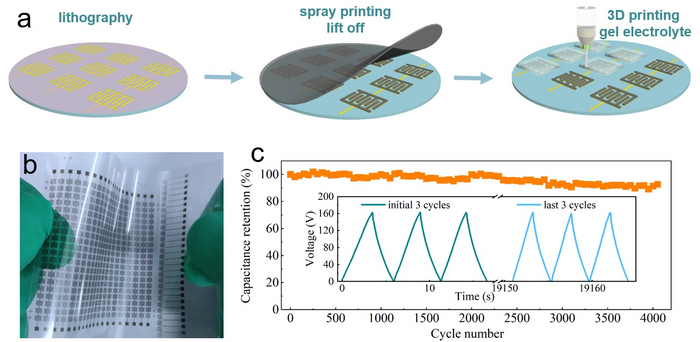Compact monolithic integrated micro-supercapacitors (MIMSCs) with high systemic performance and cell number density will become invaluable for fueling miniaturized electronics in the future, but their scalable production remains a challenge.

(a) Schematic of the fabrication of M-MIMSCs. (b) Flexibility of M-MIMSCs on a flexible polyethylene terephthalate substrate. (c) Cycling stability for 4000 cycles tested at 2.7 μA of 60 cells connected in series under output voltage of 162 V in PVDF-HFP-EMIMBF4 gel electrolyte. Image Credit: Dr. Sen Wang and Dr. Linmei Li, ©Science China Press
Numerous limitations act as roadblocks. One of the most difficult challenges to resolve is accurately depositing electrolytes on densely packed micro-supercapacitors (MSCs) while guaranteeing electrochemical isolation. Furthermore, electrochemical performance may be significantly compromised during complex microfabrication procedures, and even then, achieving performance uniformity across numerous individual cells is difficult.
To resolve these critical issues, Wu and colleagues developed an innovative and high-throughput approach for mass production of MIMSCs that combines multi-step lithographic patterning, spray printing of MXene microelectrodes, and three-dimensional (3D) printing of gel electrolyte while achieving superior cell number density and high systemic performance.
The research is headed by Prof. Zhong-Shuai Wu, Prof. Yao Lu (Dalian Institute of Chemical Physics, Chinese Academy of Sciences), and Prof. Hui-Ming Cheng (Faculty of Materials Science and Engineering/Institute of Technology for Carbon Neutrality, Shenzhen Institute of Advanced Technology, Chinese Academy of Sciences).
The group used high-resolution micropatterning techniques for microelectrode deposition and 3D printing for accurate electrolyte deposition to accomplish the monolithic integration of electrochemically isolated micro-supercapacitors in close proximity.
First, super-dense microelectrode-arrays were created using high-resolution lithographic patterning and the distinctiveness of MXene nanosheets, and each individual MXene-based MSC has an incredibly small footprint of 1.8 mm2, a high areal capacitance of 4.1 mFcm−2, a high volumetric capacitance of 457 Fcm−3, and stable performance at ultrahigh scan rates up to 500 Vs−1.
Second, they devised a straightforward, dependable, and high-throughput strategy for the electrochemical isolation of individual units. A gel electrolyte ink suitable with a novel 3D printing technique was rationally designed for this, allowing adjoining microcells to be electrochemically isolated at a close proximity of only 600 µm while providing excellent performance uniformity.
As a result, the investigators were able to acquire MIMSCs with an excellent areal number density of 28 cells cm−2 (400 cells on 3.5 4.1 cm2), a record areal output voltage of 75.6 Vcm−2, and a satisfactory systemic volumetric energy density of 9.8 mWhcm−3, all of which far outperformed those reported earlier for integrated MSCs.
The subsequent MSCs displayed superior performance consistency on a wider scale, owing to the reliability and regularity of each step in the microfabrication processes, including lithography, spray printing, lift-off, and 3D printing, and the MIMSCs demonstrated good capacitance retention of 92% after 4000 cycles at an exceptionally high output voltage of 162 V.
This innovative microfabrication strategy marks a great advance as a new technological platform for monolithic micropower sources and will aid the applications where compact integration and high systemic performance is demanded from energy storage units.
Zhong-Shuai Wu, Professor, Dalian Institute of Chemical Physics, Chinese Academy of Sciences
Journal Reference
Wang, S., et al. (2023) Monolithic integrated micro-supercapacitors with ultra-high systemic volumetric performance and areal output voltage. National Science Review. doi.org/10.1093/nsr/nwac271.